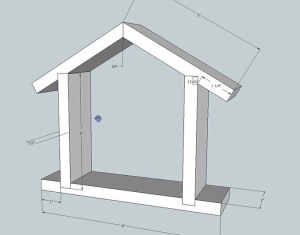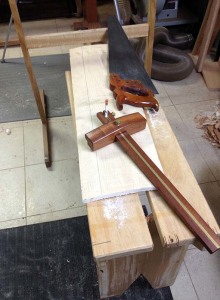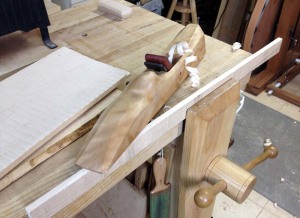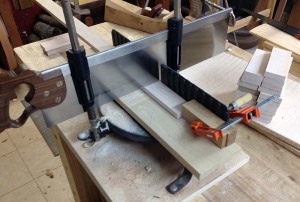Mass Production with Hand Tools
“I cut my dovetails by hand until I have to do more than 5 drawers at once, then I use a router jig”
This is a commonly heard sentiment among woodworkers these days. The assumption is that hand tools will slow you down after a point and the repeatability of machines will speed up the process when you have multiple parts. I’m not going to deny this but when I was presented with a small project where I needed to build 18 identical pieces, I was determined to find out if adding repeatability to my hand tools would close the gap on the power tool advantage.
I often build small projects for my mother-in-law’s 1st grade Sunday school class. These are always meant to be assembled by the children so I have to figure out ways to build so that minimal drying time is needed and no sharp and pointy tools are necessary. Basically this comes down to fitting joints together and securing them with pegs. In my experience age nor gender lessens the joy that comes from pounding a peg into place…then pounding on the table, and the wall, and the child next to you. Word of advice, crab mallets are the best pounding implement for kids of this age (and older). In the past I have built stools, sailboats, chariots, and even an Ark of the Covenant. This time I am presented with making a stable that the children could complete their Nativity scenes with the thread spool characters they had already made. Oh and as usual I have about 3 days notice on this project! The big catch, since the last time I did this I have sold off all my power tools. Time to put my money where my mouth is.
 So if I were building this with power tools how would I speed up the process? As stated above it all comes down to repeatability. Power tools gain an advantage by employing set fences and controlling the motion of the workpiece or by fixing the path of the cutting tool. All things that actually exist already in the hand tool shop. The most important step you can take for efficient mass production is in the design stage. Whether using hand or electric power if you can minimize the number of cuts and settings you have to make everything will go faster and be more accurate. With this in mind I designed the creche to use only 5 pieces, 4 of which would be identical. These 4 pieces would have a 30 degree angle cut on the end to form the peak of the roof and the tops of the side walls. My original angled dado cut would have been better but would have significantly increased my time and forced me to fit each creche individually.
So if I were building this with power tools how would I speed up the process? As stated above it all comes down to repeatability. Power tools gain an advantage by employing set fences and controlling the motion of the workpiece or by fixing the path of the cutting tool. All things that actually exist already in the hand tool shop. The most important step you can take for efficient mass production is in the design stage. Whether using hand or electric power if you can minimize the number of cuts and settings you have to make everything will go faster and be more accurate. With this in mind I designed the creche to use only 5 pieces, 4 of which would be identical. These 4 pieces would have a 30 degree angle cut on the end to form the peak of the roof and the tops of the side walls. My original angled dado cut would have been better but would have significantly increased my time and forced me to fit each creche individually.
 I salvaged some Hard Maple from the lumber yard that had been used as a test piece on the resaw. It was bandsawn at 1/2″ thick and around 8″ wide, and horribly cupped. I knew that once I ripped out 2″ wide strips I would eliminate most if not all of the cup. Setting my panel gauge to a hair over 2″, I marked the board, ripped the strip of, marked again, ripped a strip, etc, etc. until I had 14 pieces of 1/2x2x36 Hard Maple.
I salvaged some Hard Maple from the lumber yard that had been used as a test piece on the resaw. It was bandsawn at 1/2″ thick and around 8″ wide, and horribly cupped. I knew that once I ripped out 2″ wide strips I would eliminate most if not all of the cup. Setting my panel gauge to a hair over 2″, I marked the board, ripped the strip of, marked again, ripped a strip, etc, etc. until I had 14 pieces of 1/2x2x36 Hard Maple.
 I would need a good reference edge before crosscutting and sawing the miter so while each strip was still whole, I jointed both edges. While only one was needed, I would eventually want to clean up the other edge to prevent splinters in little fingers. This second edge would not be a reference face so all I was focused on was cleaning it up and it went quickly.
I would need a good reference edge before crosscutting and sawing the miter so while each strip was still whole, I jointed both edges. While only one was needed, I would eventually want to clean up the other edge to prevent splinters in little fingers. This second edge would not be a reference face so all I was focused on was cleaning it up and it went quickly.
Now I could begin breaking these strips into their individual components. I needed 72 pieces 5″ long and 18 pieces 7″ long. Using a piece of scrap wood I set up a stop block on my miter box and began crosscutting these strips into parts.
Dec 21, 2013 | Repeatable hand saw cuts are easy with a miter box by RenaissanceWW on Keek.com
Once all the pieces were cut to length I changed the angle of the saw and reset the stop block so that I could repeatedly cut the 30 degree angle on the end of all 72 of the 5″ pieces.
Now I needed to clean up the two faces then slightly break the sharp edges again to prevent any potential splinters while the children assembled the creches.
Dec 21, 2013 | Smooth planing lots of small parts by RenaissanceWW on Keek.com
Now on to the joinery for the sides to the base joint.
Dec 21, 2013 | Locating peg holes for dowel joinery by RenaissanceWW on Keek.com
and the mating side of the joint
Dec 21, 2013 | The mate of the dowel joint by RenaissanceWW on Keek.com
To join these pieces I would need 144 pegs about 1″ long cut from a 3/16″ dowel.
Dec 21, 2013 | Mass production of pegs by hand by RenaissanceWW on Keek.com
From here it was rinse and repeat over and over and over again. Efficiency in this project was all about keeping my tools close at hand and creating “stations” on my workbench where specific operations were done. No matter where I was during this process everything I needed was immediately at hand and I could just turn up the Christmas music and go with the flow.
Dec 22, 2013 | Last minute mass production project finished by RenaissanceWW on Keek.com
In the end I logged 6 hours on this project from rough lumber to finished projects individually bagged with all their pegs and parts together. Yes I could have probably done with with power tools in a quarter of the time and no matter how you look at it, power tools rules the day when it comes to a repeated project like this. I had a blast, got some exercise, and could not think of a better way to spread the joy I get from using hand tools. Maybe, just maybe I created some new woodworkers today too.









